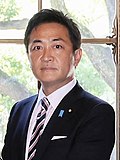Top Qs
Timeline
Chat
Perspective
2023 Japanese unified local elections
From Wikipedia, the free encyclopedia
Remove ads
The 2023 Japanese unified local elections were held across the country on 9 and 23 April 2023. In total 15,047 candidates were elected in 1,008 races with a high of 1,685 in Hokkaido and a low of 1 in Okinawa.[1]
This article may need to be rewritten to comply with Wikipedia's quality standards. (June 2023) |
The ruling Liberal Democratic Party (LDP) scored a comfortable victory. Six LDP (and Komei) endorsed candidates won the governorship. The LDP also managed to win more than half of all the prefectural assembly seats in the prefecture that held elections.[2]
Major victories were also won by Nippon Ishin no Kai. In addition to winning in its home base of Osaka, Ishin also won the contest for governor of Nara and increased the number of seats it now holds in neighboring prefectures. The party secured majorities in the Osaka prefectural and municipal assemblies for the first time ever, and they even took home six seats in the Kanagawa Prefectural Assembly.[3]
Turnouts this month were at record lows for all elections with the exception of the Hakodate mayoral contest[4] and mayoral and assembly races in Tokyo wards which were higher than the last election but still did not top 50%.[5]
This maintains a pattern in Japan, where fewer and fewer people are casting ballots ever since the LDP took back control in 2012.[4]
Remove ads
Background
Summarize
Perspective
LDP's declining popularity and Kishida's attempts to rebound it
Since the assassination of former prime minister Shinzo Abe, the historically dominant LDP began to face strong criticism over its link to the Unification Church. Abe's murderer Tetsuya Yamagami had claimed that his family was bankrupted by the church. Soon after the assassination, the Japanese media ventured into investigations which unearthed pervasive links between some of the LDP's senior politicians and the church, leading to a decline in the LDP's approval.[2]
However, Prime Minister Fumio Kishida ramped up efforts to salvage his party's reputation. He promised to double defense spending and held a meeting with the South Korean President. He also paid a surprise visit to Ukraine. These foreign and defense policy achievements bolstered his approval rating.[2][6]
Candidate shortage
One of the most critical issues of this election was a shortage of candidates. 556 candidates in nearly 40% of the districts ran uncontested. This reflected the increasingly dysfunctional nature of Japanese society due to its rapid population decline.[7]
April elections by prefecture in Stage 1 and 2
Source:[8]
1008 elections were held across all prefectures. The number of elections held by prefecture varied greatly from a low of one in Toyama and Okinawa prefectures to a high of 177 in the prefecture of Hokkaido which was by far the largest number.
Stage 1 on 9 April featured the following elections:
Stage 2 on 23 April featured the following elections:
This is the total list of all elections held on 9 and 23 April broken down by prefecture and position:
Remove ads
Results
Summarize
Perspective
Stage 1: 9 April
The LDP secured a comfortable victory in the elections. It won six of the nine gubernatorial races that were in play. Particularly pleasing for the party was its victory in Hokkaido, where the centre-left party CDP had been historically strong. The LDP however failed to do well in Western Japan, notably in Osaka and Nara.[2]
The Japan Innovation Party's victory also attracted significant attention, with political analysts predicting a strong future for it in the second round of local elections and at the national stage.[9]
Voter turnout for the all the gubernatorial elections was 46.8% while the average voter turnout for the mayoral elections in designated cities was 46.6%.
Voter turnout
Gubernatorial Elections
Designated City Mayoral Elections
Governors
LDP=Liberal Democratic Party CDP=Constitutional Democratic Party Komeito=Komei JCP=Japan Communist Party NIK=Nippon Ishin no Kai (also refers to Osaka Ishin no Kai) DPFP=Democratic Party for the People SDP=Social Democratic Party, Sanseito=Sansei, Seijika Joshi 48 Party=48
- * denotes prefectural chapter
Prefectural assemblies
LDP=Liberal Democratic Party CDP=Constitutional Democratic Party Komeito=Komei JCP=Japan Communist Party *NIK=Nippon Ishin no Kai (also refers to Osaka Ishin no Kai) DPFP=Democratic Party for the People SDP=Social Democratic Party Sanseito=Sansei
Source NHK[10] & Ministry of Internal Affairs and Communications[1]
Mayors of Designated Cities
Designated city assemblies
LDP=Liberal Democratic Party CDP=Constitutional Democratic Party JCP=Japan Communist Party *NIK=Nippon Ishin no Kai (also refers to Osaka Ishin no Kai) DPFP=Democratic Party for the People SDP=Social Democratic Party
Stage II: 23 April
After the elections on 23 April the make up of prefectures, cities, Tokyo special wards, towns, and villages which held elections during the first and second stages, look like this[1][5]
Voter Turnout
Source:[5]
Elections in both town and villages, and cities recorded record low turnouts.
Cities: 63 mayoral races/47.73%, 280 city council elections/44.26%
Towns/Villages: 55 mayoral (heads) races/60.79%, 250 council elections/55.49%.
Remove ads
Aftermath and reactions
Anticipation began to grow that, banking on the success of the local elections, Prime Minister Kishida may call a snap general election.[2]
LDP election Chief Hiroshi Moriyama was quoted as saying, "People have recognized our achievements."[3]
See also
References
Wikiwand - on
Seamless Wikipedia browsing. On steroids.
Remove ads









